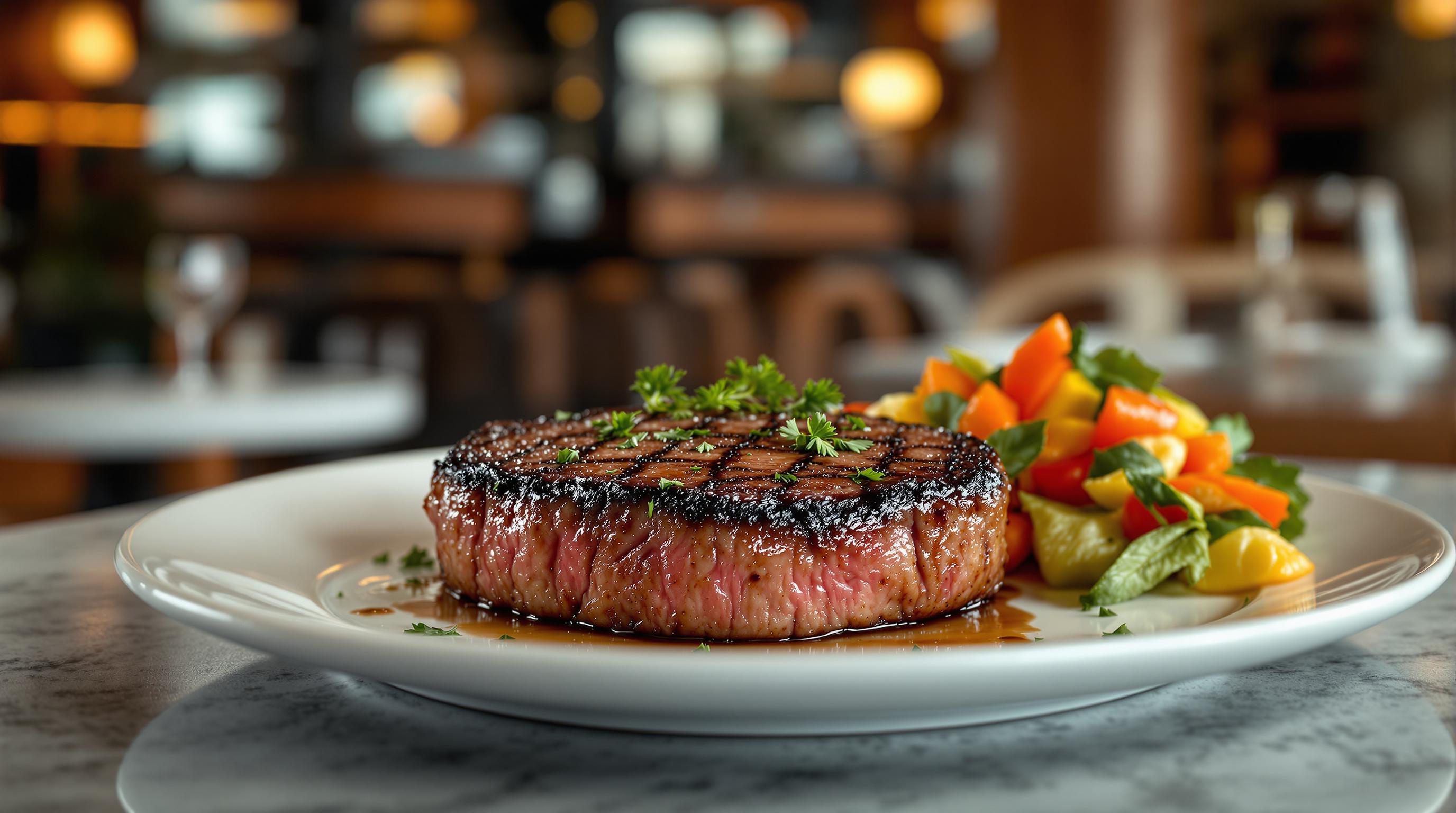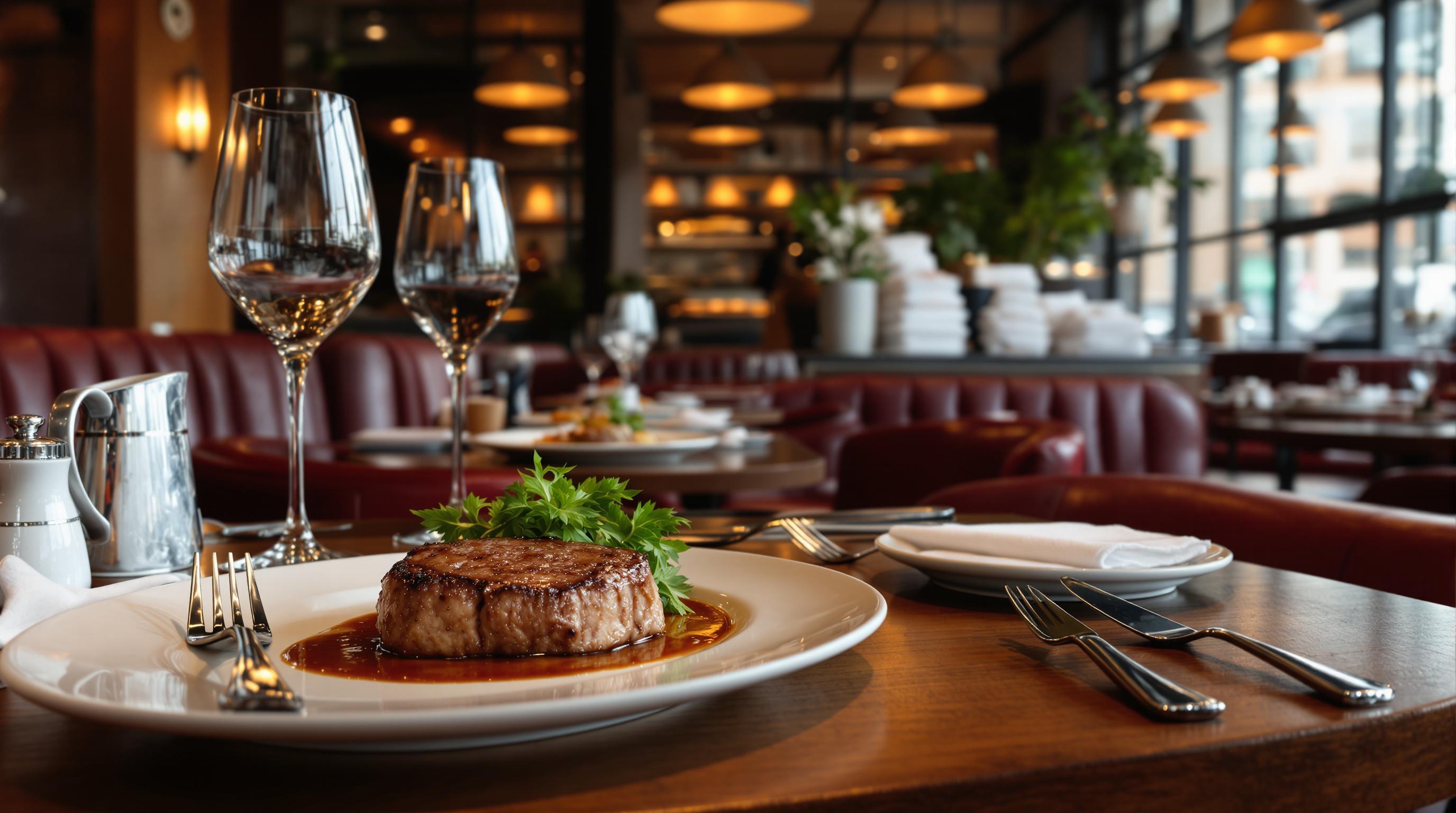Porterhouse and T-Bone steaks may look similar, but the key difference lies in the size of the tenderloin. Both cuts come from the short loin and feature a T-shaped bone, but the Porterhouse has a larger tenderloin, making it ideal for sharing, while the T-Bone's smaller tenderloin suits single servings. Here's a quick breakdown:
- Porterhouse: Larger tenderloin, great for sharing, more expensive, takes longer to cook.
- T-Bone: Smaller tenderloin, bold strip steak flavor, more affordable, quicker to cook.
Quick Comparison Table
| Feature | Porterhouse | T-Bone |
|---|---|---|
| Tenderloin Size | Larger, buttery texture | Smaller, subtle tenderness |
| Strip Steak | Generous portion | Similar portion |
| Cooking Time | Longer (due to size) | Shorter |
| Best For | Sharing or hearty meals | Single serving or lighter meal |
| Cost | Higher | More affordable |
Choose the Porterhouse for a mix of tender and bold flavors, perfect for special occasions. Opt for the T-Bone if you prefer a rich, beef-forward steak that cooks faster. Both cuts deliver a classic steakhouse experience.
Ask the Butcher - T-Bone vs. Porterhouse: What's the ...
Meat Cut Basics
Both steaks are defined by their signature T-bone, which separates the strip steak and tenderloin portions. The main difference? The size of the tenderloin, which gives each cut its unique appeal.
Porterhouse Cut
The Porterhouse comes from the short loin and is known for its larger tenderloin paired with a hearty strip steak. Here's what makes it stand out:
- Strip Side: A sizable portion of strip steak.
- Tenderloin Side: A larger tenderloin, celebrated for its soft, buttery texture.
The Porterhouse is easily recognized by its more generous tenderloin portion, making it a favorite for those who enjoy a tender, flavorful cut.
| Porterhouse Components | Key Features |
|---|---|
| T-shaped Bone | Separates the two muscle sections |
| Strip Loin Side | Substantial strip steak portion |
| Tenderloin Side | Larger, softer tenderloin |
T-Bone Cut
The T-Bone also comes from the short loin, but it has a smaller tenderloin compared to the Porterhouse. It combines the bold flavor of the strip steak with a hint of filet tenderness.
| T-Bone Components | Key Features |
|---|---|
| T-shaped Bone | Central dividing bone |
| Strip Loin Side | Similar portion of strip steak |
| Tenderloin Side | Smaller, yet tender filet portion |
Both cuts offer the best of two worlds: the rich flavor of the strip steak and the tenderness of the filet. The difference in tenderloin size not only affects the dining experience but also the price and cooking methods.
Grasping these basics makes it easier to understand the physical distinctions you'll see in the next section.
Physical Differences
At first glance, both steaks feature the iconic T-shaped bone, but the size of the tenderloin sets them apart.
Porterhouse Size
The Porterhouse is larger overall and comes with a bigger tenderloin, making it perfect for sharing. Its size also means it takes longer to cook.
T-Bone Size
The T-Bone, with its smaller tenderloin, is great for a hearty single serving or a lighter meal for two. These size differences impact cooking: the Porterhouse needs more time, while the T-Bone cooks quicker.
Taste and Texture
These two cuts offer distinct flavor profiles, largely influenced by their tenderloin-to-strip ratios. The Porterhouse, with its larger tenderloin, offers a different experience compared to the T-Bone.
Porterhouse Taste
The Porterhouse combines a sizable tenderloin with a flavorful strip steak, striking a balance between tenderness and bold taste. The tenderloin side is soft and mild, while the strip side, with its marbling, delivers a rich, beefy flavor. Together, they create a mix of textures and flavors that stand apart from the T-Bone's more uniform taste.
| Meat Component | Texture | Flavor Profile |
|---|---|---|
| Tenderloin Side | Soft and tender | Mild, buttery |
| Strip Side | Firm, marbled | Deep, beefy |
| Overall Experience | Varied textures | Balanced and layered |
T-Bone Taste
The T-Bone, with its smaller tenderloin, leans into a more consistent, beef-forward flavor. The strip steak takes center stage, offering a rich and savory taste, while the tenderloin plays a subtle supporting role.
This straightforward composition makes the T-Bone an ideal choice for those who enjoy the quintessential steakhouse flavor, emphasizing the hearty taste of the strip steak.
sbb-itb-e6be165
Cooking Guide
Cooking these cuts depends on their size and structure, which influence the methods and timing. Here's how to handle each cut for the best results.
Porterhouse Cooking Steps
The Porterhouse steak requires careful attention to cook both the tenderloin and strip portions evenly. Using a combination of techniques is key.
| Cooking Phase | Temperature | Duration | Technique |
|---|---|---|---|
| Initial Sear | 500°F | 3-4 mins per side | Cast iron skillet |
| Indirect Heat | 275°F | 15-20 mins | Oven roasting |
| Rest | Room temp | 10-12 mins | Tented foil |
Tips for a perfect Porterhouse:
- Let the steak come to room temperature before cooking.
- Season generously with kosher salt and freshly ground black pepper.
- Use the reverse sear method for even cooking.
- Keep a close eye on the internal temperature, aiming for 135°F for medium-rare.
- Rest the steak properly under tented foil before slicing.
T-Bone steaks, being thinner, require a slightly different approach.
T-Bone Cooking Steps
T-Bone steaks, with their smaller tenderloin portion, are easier to cook with a more straightforward method.
| Cooking Phase | Temperature | Duration | Technique |
|---|---|---|---|
| Direct Heat | 450°F | 4-5 mins per side | Grill or skillet |
| Rest | Room temp | 5-7 mins | Loosely draped foil |
Tips for a perfect T-Bone:
- Cook at high heat for a shorter time.
- Aim for an internal temperature of 130°F for medium-rare.
- Allow the steak to rest briefly before serving.
Pro Tip: Place the tenderloin side away from the hottest part of the grill or skillet to prevent overcooking. The strip side can handle more direct heat due to its fat content and density.
Keep in mind that the thicker Porterhouse generally needs about 25-30 minutes of total cooking time, while the thinner T-Bone typically requires just 15-20 minutes from start to finish.
Cost Comparison
Understanding the price differences between cuts can help you make smarter decisions, whether you're dining out or shopping at a butcher.
Porterhouse Costs
Porterhouse steaks often come with a higher price tag. This is due to their larger size and the inclusion of the tenderloin, which makes them a pricier option. In upscale steakhouses, especially in big cities, you'll frequently find Porterhouse steaks listed at premium prices compared to other cuts.
T-Bone Costs
T-Bone steaks tend to be more affordable. Their smaller size and greater availability contribute to their lower cost. Prices can also fluctuate based on demand and market trends, so keeping an eye out for promotions is a good way to save.
Prices vary depending on location and where you shop or dine. To get the most accurate pricing, check with your local butcher or steakhouse. These variations also influence pricing strategies in NYC steakhouses, which will be discussed next.
NYC Steakhouse Options
New York City is home to some top-notch steakhouses where classic cuts like Porterhouse and T-Bone are prepared with care and expertise. Each venue brings its own flair to these timeless steaks, offering unique dining experiences.
Peter Luger Steak House is a true NYC icon. Known for its no-frills, cash-only policy and German beer hall vibe, it specializes in dry-aged beef, which enhances the natural flavors of the meat. Over in Midtown, Smith & Wollensky sticks to tradition with its dry-aged steaks and classic preparation methods, making it a reliable choice for steak lovers.
For a more modern touch, Porter House Bar and Grill combines premium cuts with contemporary techniques. Located in the Time Warner Center, this upscale spot also boasts stunning Central Park views, adding to its appeal.
Historic steakhouses also play a big role in NYC's steak scene. Keens Steakhouse, with its wood-paneled rooms and club-like atmosphere, serves hearty portions of both Porterhouse and T-Bone cuts. Meanwhile, Sparks Steak House, a Midtown staple since 1966, continues to impress with its focus on high-quality meat and expert preparation.
Here’s a quick comparison of these standout steakhouses:
| Steakhouse | Signature Style | Notable Features |
|---|---|---|
| Peter Luger Steak House | Dry-aged, broiled | Cash-only, German beer hall atmosphere |
| Porter House Bar and Grill | Modern technique | Central Park views, contemporary setting |
| Keens Steakhouse | Traditional broiling | Historic decor, club-like ambiance |
| Sparks Steak House | Classic preparation | Established in 1966, traditional setting |
| Smith & Wollensky | Dry-aged, traditional | Old-school service |
When choosing where to enjoy a Porterhouse or T-Bone, think about the aging process, cooking style, and the overall vibe of the place. Each steakhouse offers a distinct take on these classic cuts, ensuring a memorable dining experience in the heart of NYC.
For detailed reviews and more options, check out the NY Steakhouse Guide at NY Steakhouse Guide.
Conclusion
Choose based on your dining preferences: the Porterhouse offers a larger tenderloin, making it perfect for sharing during a special meal, while the T-Bone is ideal for a single serving. This distinction can help you decide what suits your next NYC dining outing. For top steakhouse recommendations in NYC, check out NY Steakhouse Guide for detailed reviews.


